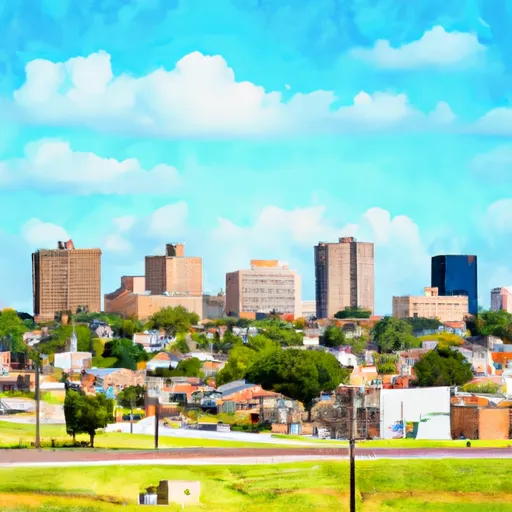-
 Snoflo Premium
Snoflo Premium
Get unlimited access to all our content
With no Ad interruptions! - Start Your Free Trial Login with existing account
Justiceburg
Eden Index
Climate
9.2
•
Recreation
1.6
•
Community
•
Safeguard
4.2/10

Justiceburg is a small unincorporated community located in Garza County, Texas. Situated in the South Plains region, it experiences a semi-arid climate characterized by hot summers and mild winters. Summers are typically hot and dry, with temperatures often exceeding 90°F, while winters are generally mild with occasional cool spells.
In terms of hydrology constituents, Justiceburg is part of the Brazos River watershed. The region's hydrology is influenced by reservoirs, including the nearby Lake Alan Henry. This reservoir provides water for irrigation, recreation, and domestic use.
Justiceburg boasts several outdoor recreation opportunities. Lake Alan Henry is a popular spot for fishing, boating, and swimming. Anglers can find a variety of fish species, including largemouth bass, catfish, and crappie. The lake also features several camping areas and hiking trails, allowing visitors to immerse themselves in the scenic beauty of the area. Additionally, the nearby Caprock Canyons State Park offers opportunities for hiking, mountain biking, and wildlife viewing. With its diverse outdoor activities, Justiceburg is a haven for nature enthusiasts seeking to explore the beauty of West Texas.
What is the Eden Index?
The Snoflo Eden Index serves as a comprehensive rating system for regions, evaluating their desirability through a holistic assessment of climate health, outdoor recreation opportunities, and natural disaster risk, acknowledging the profound impact of these factors on livability and well-being.
Climate Health Indicator (CHI): 9.2
Justiceburg receives approximately
495mm of rain per year,
with humidity levels near 78%
and air temperatures averaging around
17°C.
Justiceburg has a plant hardyness factor of
7, meaning
plants and agriculture in this region tend to thrive during the non-winter months.
By considering the ideal temperature range, reliable water supplies, clean air, and stable seasonal rain or snowpacks, the Climate Health Indicator (CHI) underscores the significance of a healthy climate as the foundation for quality living.
A healthy climate is paramount for ensuring a high quality of life and livability in a region, fostering both physical well-being and environmental harmony. This can be characterized by ideal temperatures, reliable access to water supplies, clean air, and consistent seasonal rain or snowpacks.
Weather Forecast
Streamflow Conditions
Brazos Headwaters
Area Rivers
Brazos Headwaters
Snowpack Depths
Brazos Headwaters
Reservoir Storage Capacity
Brazos Headwaters
Groundwater Levels
Recreational Opportunity Index (ROI): 1.6
The Recreational Opportunity Index (ROI) recognizes the value of outdoor recreational options, such as parks, hiking trails, camping sites, and fishing spots, while acknowledging that climate plays a pivotal role in ensuring the comfort and consistency of these experiences.
Access to outdoor recreational opportunities, encompassing activities such as parks, hiking, camping, and fishing, is crucial for overall well-being, and the climate plays a pivotal role in enabling and enhancing these experiences, ensuring that individuals can engage in nature-based activities comfortably and consistently.
Camping Areas
| Campground | Campsites | Reservations | Toilets | Showers | Elevation |
|---|---|---|---|---|---|
| Rivercrest Rd - White River Reservoir | None | 2,410 ft | |||
| Sandy Beach Park - Lake J. B. Thomas | None | 2,287 ft | |||
| Bull Creek Park - Lake J. B. Thomas | None | 2,271 ft | |||
| Moss Creek Lake Park | 55 | 2,369 ft | |||
| Crosbyton City RV Park | None | 3,008 ft | |||
| Marina - White River Reservoir | None | 2,375 ft | |||
| Samuel W. Wahl Rec Area | 40 | 2,251 ft | |||
| White Island Park - Lake J. B. Thomas | None | 2,265 ft | |||
| South Side Park - Lake J. B. Thomas | None | 2,269 ft | |||
| Lake Colorado City State Park | 33 | 2,117 ft |
Nearby Fishing
Nearby Ski Areas
Catastrophe Safeguard Index (CSI):
The Catastrophe Safeguard Index (CSI) recognizes that natural disaster risk, encompassing floods, fires, hurricanes, and tornadoes, can drastically affect safety and the overall appeal of an area.
The level of natural disaster risk in a region significantly affects safety and the overall livability, with climate change amplifying these risks by potentially increasing the frequency and intensity of events like floods, fires, hurricanes, and tornadoes, thereby posing substantial challenges to community resilience and well-being.
Community Resilience Indicator (CRI):
The Community Resilience Indicator (CRI) recognizes that education, healthcare, and socioeconomics are crucial to the well-being of a region. The CRI acknowledges the profound impact of these elements on residents' overall quality of life. By evaluating educational resources, healthcare accessibility, and economic inclusivity, the index captures the essential aspects that contribute to a thriving community, fostering resident satisfaction, equity, and social cohesion.

